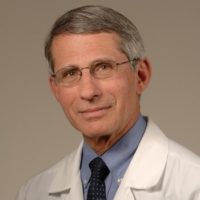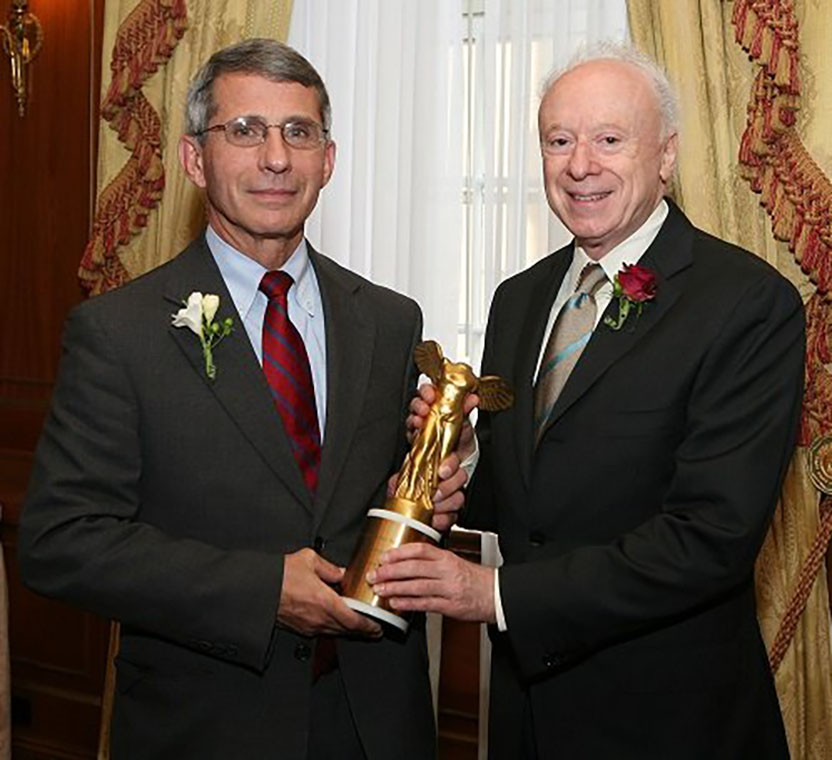At the College of the Holy Cross in Worcester, Massachusetts, Tony elected to pursue a career in medicine and took a combined course in Greek and premedical studies. To one schooled in the Jesuit custom of reconciling contradictory concepts, this is not so great a stretch as it may seem. Tony earned his medical degree at Cornell Medical School in 1966 and began his residency at New York Hospital-Cornell Medical Center. Like many considering a career in academic medicine, Tony sought an opportunity to round out his clinical training with an experience in bench research. The perfect opportunity arose at the National Institute of Allergy and Infectious Diseases, where Tony was simultaneously able to obtain fellowship training in infectious diseases. Under the tutelage of the redoubtable Sheldon Wolff, Tony discovered an aptitude for research that rivaled his satisfaction with patient care. He accepted an invitation to start his own laboratory at NIAID, to begin after returning from a year serving as chief medical resident at New York Hospital. Now, however, rather than a sojourn in science to prepare for life as an academic physician, Tony's chief residency rounded out his preparation for the pursuit of scientific discoveries that would save patients' lives.
And save lives he did. Tony Fauci's early discoveries of immunoregulatory factors led to successful treatment of previously fatal inflammatory conditions such as vasculitis and Wegener's granulomatosis. In 1980, Dr. Fauci became chief of the Laboratory of Immunoregulation at NIAID, a post he retains to this day. When the first clinical reports of what we now know as AIDS appeared in 1981, Tony presciently redirected his laboratory to focus on the immunobiology of AIDS and, once the causative agent was identified, of HIV.
One unanticipated benefit of this new direction was the opportunity it afforded Tony to meet and fall in love with Christine Grady, then a nurse in charge of caring for AIDS patients, and now a celebrated medical ethicist, Tony's wife, and mother of their three daughters. Two of their children, Jenny and Alison, are here. Megan, the middle one, is following in the family tradition of service to others — today starting her AmeriCorps service in Chicago.
When Dick Krause stepped down as director of NIAID in 1984, Jim Wyngaarden, the NIH director at the time, wisely turned to its rising star, Tony Fauci, to take the helm. In the more than 20 years since, through the NIH directorships of Bernadine Healy, Harold Varmus, and now, Elias Zerhouni, no Institute has undergone more dramatic growth and development than NIAID, and none has been marked by steadier, continuing leadership.
Throughout his career, Tony Fauci has been a prolific and influential scientist, with more than 1100 publications to his credit. His work is among the most frequently cited by other researchers. He is a member of the National Academy of Sciences and of the Institute of Medicine. He has received enough honorary degrees to paper over one of the very capacious walls in this room (including the mirrors). He is a recipient of the National Medal of Science, the George M. Kober Medal from the Association of American Physicians, its highest honor, and the Julius Richmond Medal from the Harvard School of Public Health — and these just in the last year or so. No one, as a scientist and institutional leader, has done more to set the pace and direction of the world's scientific response to HIV than Tony Fauci, the man we recognize today for yet other good and sufficient reasons.
When George Herbert Walker Bush was vice president, he requested a briefing at the NIH in order to get a better grasp of the AIDS pandemic. Jim Wyngaarden asked Dr. Fauci to organize the visit. The vice president, accompanied by Barbara Bush, spent a half day with Tony, visiting patients, seeing laboratories, and gaining new insight into the tragedy, scope, and complexity of the HIV pandemic. The vice president corresponded with Tony, invited him to dinners and meetings, and they became friends. Working with President George H. W. Bush, and with members of Congress from both parties, Tony solidified a reputation as a savvy and impartial scientist who could be an honest broker in policy deliberations. This role as trusted scientific adviser only strengthened and enlarged through the Clinton and George W. Bush administrations. Companion to presidents and confidante to Congress — one can only wonder whether this future ever entered the mind of the young Tony Fauci playing stickball in the streets of Brooklyn.
With his striking ability to synthesize, to reconcile divergent views, to think on his feet, and to express himself clearly, Tony has frequently been called by the media to speak on complicated scientific and health matters, such as AIDS, SARS, anthrax, multi-drug-resistant organisms, and pandemic influenza. If the public is informed and enlightened by Tony's direct, thoughtful, and understandable words, his scientific colleagues always appreciate Tony's remarkable ability to simplify and explain without distortion. Tony's distinctive and authentic Brooklyn cadence stands in marked contrast to the flat, colorless, practiced vowels that mark the locution of many media personalities. You can take the boy out of Brooklyn, but you cannot take Brooklyn out of the boy.
In the spring of 2002, President Bush asked Tony and HHS Secretary Tommy Thompson, along with others, to visit Africa and to scope out what more the United States could constructively do about AIDS. This was in the aftermath of the nevirapine trial in Uganda, which demonstrated how a simplified and affordable drug regimen could markedly reduce the frequency of mother-to-child transmission of HIV. After the trip, the Secretary and Josh Bolten, then deputy chief of staff for policy at the White House, asked Tony to put together a plan for a $500 million program to prevent mother-to-child transmission.
When the president heard the proposal, he liked it, but he asked for more — a really big project that would be transforming, accountable, and feasible. Tony Fauci became the principal scientific architect, working with White House and other staff, to design the most ambitious, international health program ever mounted by the United States — the President's Emergency Plan for AIDS Relief, known in the acronym-rich environment (ARE) of Washington as PEPFAR. This $15 billion program aims to prevent 7 million new HIV infections, treat 2 million infected individuals with antiretroviral therapy, and provide care for 10 million HIV-infected patients and AIDS orphans. According to an evaluation by the Institute of Medicine released this past spring, PEPFAR is off to a promising start, extending many thousands of lives that would otherwise be lost, and now needs to be more fully integrated into health care, given flexibility to meet local conditions in different countries, and made sustainable. PEPFAR presents a positive face of America to the world; it is the American international venture of which we can all be proud. As citizens who care about the well-being of others in the world and about America's place in the world, we owe a debt of gratitude to the man on whom our leaders relied to bring scientific knowledge, clinical expertise, and practical judgment to the design of this landmark program in foreign assistance and AIDS relief.
In the same State of the Union message where he announced his plan for AIDS, on the 28th of January, 2003, President Bush called for a comprehensive research and development program that would better protect the nation against the threat of bio-terrorism. As the designer of this bio-defense program, Tony Fauci understood that it would require mobilizing industry as well as universities and government agencies. Tony championed the idea that the steps to prepare against biological agents delivered by malevolent humans would simultaneously protect the public against natural threats of emerging and re-emerging infectious diseases. Signed into law in July 2004, Project Bioshield is accelerating research, development, purchase, availability, and deployment of effective countermeasures against agents of bio-terrorism. Because of the foresight, initiative, and persuasiveness of Tony Fauci, every American can rest a little easier.
Anthony Fauci is the consummate citizen-physician-scientist. Ingenious in the laboratory, he has applied his genius equally to the tasks of managing a large scientific enterprise and leading in the design of policies that save lives, protect our health, and advance America's contributions to the health and well-being of people elsewhere in the world. Guided throughout his life by a devotion to public service, it is altogether fitting that on this occasion, the Albert and Mary Lasker Foundation bestow the Mary Woodard Lasker Public Service Award on Dr. Anthony Fauci.


